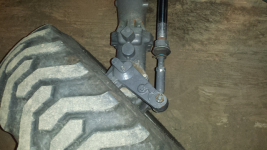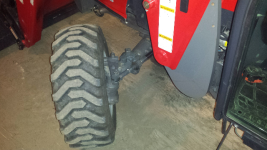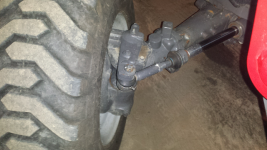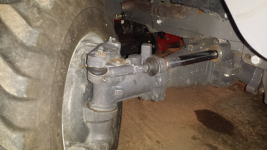
LOL Wrong. The manual does not say have a 1000lbs on the back or your tractor or in this case tie rod flange will break. As I said if it were needed it should be sold as such. And as it is I did have a counterweight attached, the backhoe specifically, and bought it as such and was told by the dealer when I bought it I shouldn't have any problems. And also conversely the manual does not say take your counterweight or in this case backhoe off if using the FEL or your tie rod flange will break. And more importantly, that counterweight as any counterweight does indeed do is add to the stresses on that flange in a turn. It's a dynamics problem not statics a little bit of Newtonian physics too...object in motion...yaw IE moment.
Cast is traditionally used because it is a lot less expensive to machine a few surfaces than hog out a solid block of say maraging steel which is far stronger. And LOL you really need to get to know someone before you assume they don't know much about materials or construction. Just google the cast and steel strength wikis its all out there now, no need for the old strength of materials book, even the strongest cast steel alloy is less than half of various high strength steels. Cast is brittle and can't be welded. I never used cast in any of my designs but then they all had to work and work at -25F and up to +120F with solar load IE MIL-STD-810C and not the wimpy F version today and they have been in service for going on 30 years now. But I don't need my 30 years experience or my engineering degree or a finite element analysis of which I have done thousands along with all the tensile and shear tests I've done to tell me that flange is way too wimpy for being made of cast if it is indeed taking the force instead of the cylinders. Proof is in the putting it broke twice. Note I am not saying it needs to be hogged out of a block of maraging steel, a cast flange would be fine as the price of the tractor is affordable and I want to keep it that way, but it does have to be designed properly for being cast IE thick enough to handle the force and apparently its not. It could also be a manufacturing or impurity issue but even that would be ok if compensated for in more material IE thicker and wider.
A comparison IS apropos, no need for that large of a cylinder unless you need that much force and...you do, the comparison is of the amount of raw force that large of a cylinder can develop vice what the wimpy tie rod and cast flange can tolerate. The comparison lends to the idea that one cylinder should expand while the other contracts. But it doesn't. Not according to the dealer and when it broke I immediately stopped and the wheels kept pushing out all by themselves. So both cylinders were expanding. I too thought that was how those worked and asked him if there was a hydraulic problem or adjustment but he said no it doesn't work that way. Well LOL I guess he's right because it didn't, they both expanded. Now I could understand that small a flange and tie rod if they acted as a follower then that would be fine, more than sufficient. But it doesn't work that way according to the dealer. And if true as the dealer claims and what I saw supports that then that flange is simply too wimpy being made of cast to bear that kind of force. It's too bad because those massive cylinders and their attachment to the hub could easily handle that much force if one expanded and the other contracted. But it just isn't so.
Glad you mentioned that. The dealer said the hubs were a known from LS problem that they supposedly corrected for the XR's and he did say they broke in a different place on the R's. And as I said this is the third one he has seen broke, I guess this will make it the fourth unless he has had more since then. I did not ask how many previous generation R's versus this years XR's he has seen I'll ask tomorrow. The dealer said because of the problem he kept the R model hubs in stock so LOL I think that tells it right there. The implication is some of the old R series have bad batch hubs unless you have had them replaced. But the XR hubs are different so he had to order. That may imply a design change from the R to XR. And if so, that may imply that the new weak link has been found and it is that wimpy flange. Again he claims they had a bad batch and all on the same side well I guess the replacements are bad too LOL.
Agree something strange is going on and I hope LS fixes it.





